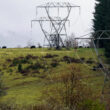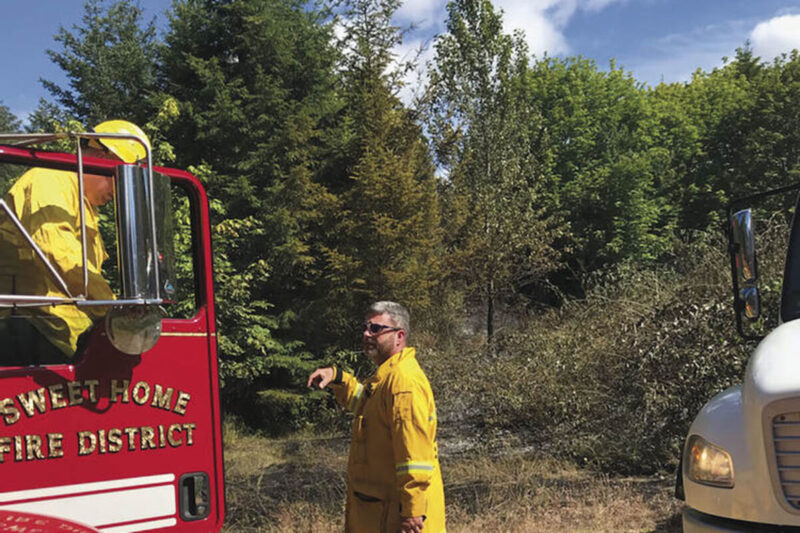Kelly Kenoyer
Coronavirus has put a bit of a damper on the routine and camaraderie that comes along with fire season, but Oregon firefighters are getting ready regardless as the summer heats up.
The Oregon Department of Forestry has officially raised fire danger level in East Linn County to “moderate,” and the agency is asking residents and visitors to take care to prevent forest fires.
Forest Protection Supervisor Chad Calderwood said, “It hasn’t rained, and things are starting to cure out… We have a lot of grass out there and it’s just dying.”
With fire danger at the moderate level, ODF restricts mowing dried, cured grass to the cooler times of day, before 1 p.m. or after 8 p.m. Use of power saws and welding are limited to the same hours. Motor vehicles and other combustion engines are only allowed on improved roads free of flammable vegetation during the peak heat of the afternoon and evening.
“Get the information before you go out, on what you can and can’t do,” Calderwood said. “They can talk to one of our firefighters if they see him around, but try to get the information and build some knowledge before they go out and just start putting fire on the ground for a s’mores cookout.”
Craig Pettinger, Sweet Home unit forester, said it’s surprising how many fires are started each year from folks parking their cars on dead grass or from mowing dry grass and hitting a rock, causing a spark.
Last week ODF responded to a one-acre brush fire near the railroad tracks at 47th and Osage, the first fire of the season for the South Cascade district.
Preventing forest fires may be more important than ever this year with concerns about protecting firefighters from coronavirus. Because of the ongoing pandemic, local fire crews are now comprised of two firefighters in a truck, who are given extra supplies like toilet paper and MREs to last two weeks in the woods.
“Like you were going camping for 14 days, essentially,” Pettinger said. “Those two people get to spend the summer together.”
That method of dispersed fire monitoring is called “spiking out,” as small units dissipate into the woods and work independently instead of all coming together in a large-scale fire camp. It allows firefighters to isolate from each other and prevent COVID-19 from spreading.
If a larger fire breaks out, things get a little more logistically complicated, said Marcus Kauffman, a spokesperson for ODF.
“This year, our federal partners, Forest Service and BLM, they’re more committed than ever to keeping fire small, because of the impact of having too much smoke in the air, and the impacts of having a large fire where you need to bring in a lot of personnel to fight the fire at a fire camp.”
In the past, large fires drew hundreds or thousands of fire crew members together from all across the region.
“What we would see is essentially a small city that pops up that provides for all of the needs of the personnel,” including “food, tents, communication, medical, all the stuff that happens at the incident command post, computer networks, WiFi, all of that,” Kauffman said.
But in the midst of a dangerous viral pandemic, massive gatherings like that aren’t as safe.
Kauffman said the individual fire crews of 10 to 20 people will need to isolate from each other within the camps.
Instead of sending a representative from each crew to the morning briefings with hundreds of people, “we’re going to broadcast that briefing, either via radio,” or with a division chief briefing each crew individually.
Similarly to the spiked-out ODF crews, “we’re gonna have pre-packaged food that either gets dropped at a location, or we send a crew representative to go pick it up for their crews.”
Kauffman said there’s a lot of discussion within the forest fire community about how to operate safely.
“The incidents that are happening right now in Arizona and New Mexico with Team deployments, we’re watching those very closely, and those incident management teams are writing up their lessons learned and sharing them with us out west,” he said.
There is limited research on whether wildland firefighters are more vulnerable to COVID-19 because of their long-term exposure to smoke. But studies show that exposure to carcinogens and toxins in smoke lead to a higher risk of lung cancer and cardiovascular disease, according to FEMA. And by the end of a two-week deployment, a lot of firefighters often have lowered immune systems. The typical cold that hits firefighters at the end of a run is called “camp crud,” Kauffman said. “I’ve caught camp crud. It’s just like public school, you know, it runs through the camp.”
Firefighters are used to smoke and used to risks, but Kauffman said this fire season will be about mitigating public health risks as much as possible. His advice for firefighters: “You need to take responsibility for yourself, wash your hands, maintain good hygiene, eat right, get good rest, you know, all those kinds of things that you need to do.”
Volunteers Needed
The Red Cross is seeking local volunteers to support sheltering efforts and health services in case of wildfires. With coronavirus limiting the deployment of trained volunteers, the Red Cross wants to activate local volunteers, especially health professionals. Those interested in volunteering, especially “RN, LPN, LVN, APRN, NP, EMT, paramedic, MD/DO or PA’s with an active, current and unencumbered license,” should sign up at redcross.org or email [email protected].





